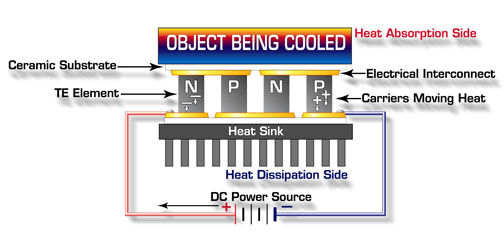Technical Support
Home > Technical Support
1. How does a thermoelectric cooling module work? |
|
Thermoelectric modules are solid-state heat pumps that operate on the Peltier effect (see definitions). A thermoelectric module consists of an array of p- and n-type semiconductor elements that are heavily doped with electrical carriers. The elements are arranged into array that is electrically connected in series but thermally connected in parallel. This array is then affixed to two ceramic substrates, one on each side of the elements (see Fig. 1). Let’s examine how the heat transfer occurs as electrons flow through one pair of p- and n-type elements (often referred to as a “couple”) within the thermoelectric module: Fig. 1 Schematic of the thermoelectric cooling module work The p-type semiconductor is doped with certain atoms that have fewer electrons than necessary to complete the atomic bonds within the crystal lattice. When a voltage is applied, there is a tendency for conduction electrons to complete the atomic bonds. When conduction electrons do this, they leave “holes” which essentially are atoms within the crystal lattice that now have local positive charges. Electrons are then continually dropping in and being bumped out of the holes and moving on to the next available hole. In effect, it is the holes that are acting as the electrical carriers. Electrons move much more easily in the copper conductors but not so easily in the semiconductors. When electrons leave the p-type and enter into the copper on the cold-side, holes are created in the p-type as the electrons jump out to a higher energy level to match the energy level of the electrons already moving in the copper. The extra energy to create these holes comes by absorbing heat. Meanwhile, the newly created holes travel downwards to the copper on the hot side. Electrons from the hot-side copper move into the p-type and drop into the holes, releasing the excess energy in the form of heat. The n-type semiconductor is doped with atoms that provide more electrons than necessary to complete the atomic bonds within the crystal lattice. When a voltage is applied, these extra electrons are easily moved into the conduction band. However, additional energy is required to get the n-type electrons to match the energy level of the incoming electrons from the cold-side copper. The extra energy comes by absorbing heat. Finally, when the electrons leave the hot-side of the n-type, they once again can move freely in the copper. They drop down to a lower energy level, and release heat in the process. The above explanation is imprecise as it does not cover all the details, but it serves to explain in words what are otherwise very complex physical interactions. The main point is that heat is always absorbed at the cold side of the n- and p- type elements, and heat is always released at the hot side of thermoelectric element. The heat pumping capacity of a module is proportional to the current and is dependent on the element geometry, number of couples, and material properties. |
- GO UP: Is first
- NEXT: Is the last one







